The Patriot Hellfire M.2 480GB Review: Phison NVMe Tested
by Billy Tallis on February 10, 2017 8:30 AM ESTRandom Read Performance
The random read test requests 4kB blocks and tests queue depths ranging from 1 to 32. The queue depth is doubled every three minutes, for a total test duration of 18 minutes. The test spans the entire drive, which is filled before the test starts. The primary score we report is an average of performances at queue depths 1, 2 and 4, as client usage typically consists mostly of low queue depth operations.
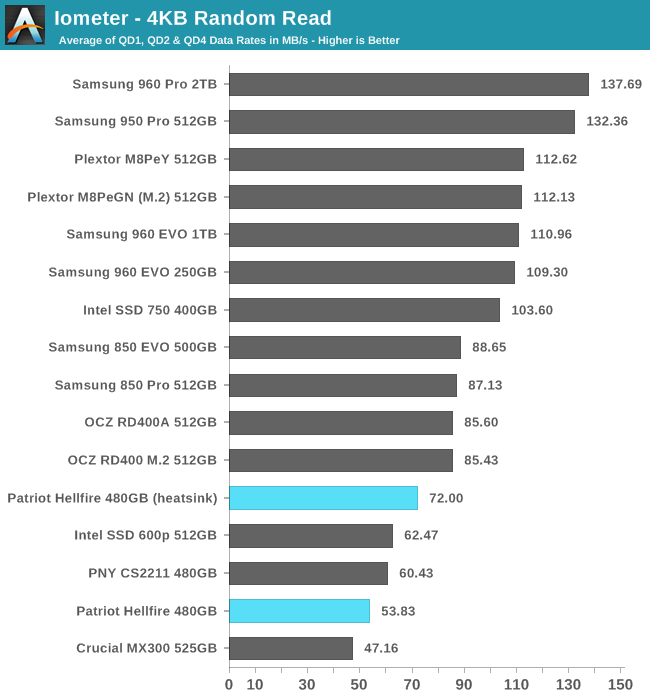
The random read performance of the Patriot Hellfire is disappointing, even when aided by a heatsink. Samsung's SATA SSDs outperform the Patriot Hellfire, and the Plextor M8Pe is twice as fast. The PNY CS2211—based on the same NAND and Phison's S10 SATA SSD controller—is the most embarrassing drive for the Hellfire to lose to.
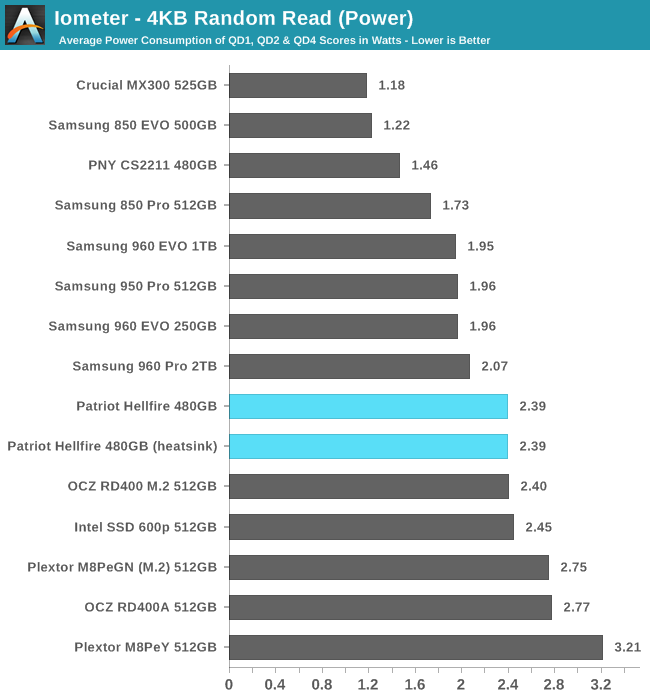
With no particular advantage in power consumption, the Patriot Hellfire gets a very poor efficiency score for random reads.
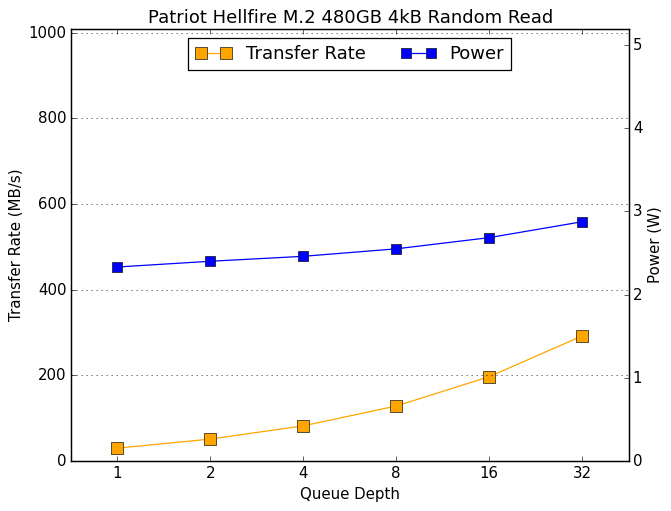 |
|||||||||
The poor random read performance at lower queue depths continues at higher queue depths, and the Patriot Hellfire cannot catch up to the Samsung 850 Pro without a heatsink.
Random Write Performance
The random write test writes 4kB blocks and tests queue depths ranging from 1 to 32. The queue depth is doubled every three minutes, for a total test duration of 18 minutes. The test is limited to a 16GB portion of the drive, and the drive is empty save for the 16GB test file. The primary score we report is an average of performances at queue depths 1, 2 and 4, as client usage typically consists mostly of low queue depth operations.
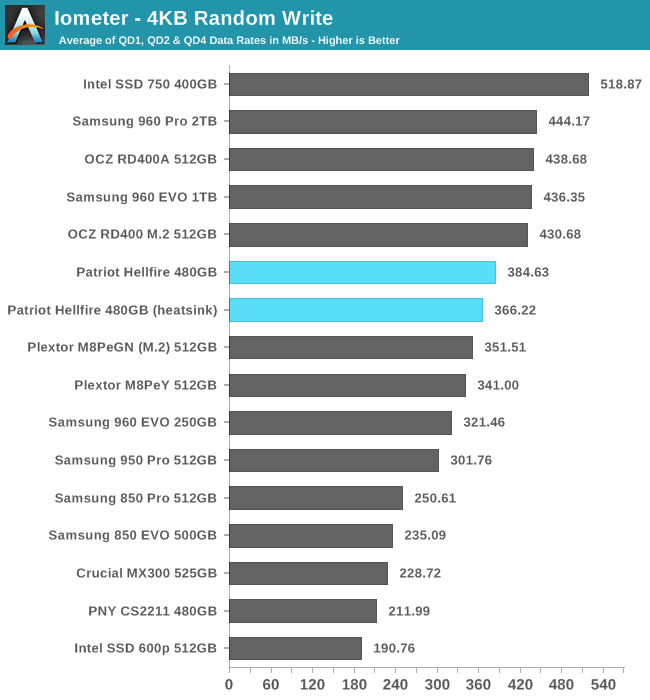
The random write performance of the Patriot Hellfire is relatively good, but it is not in the top tier. The average score with a heatsink is actually slightly lower than without, likely because the heatsink allows for higher performance early in the test, and then the drive's spare area starts to run out sooner.
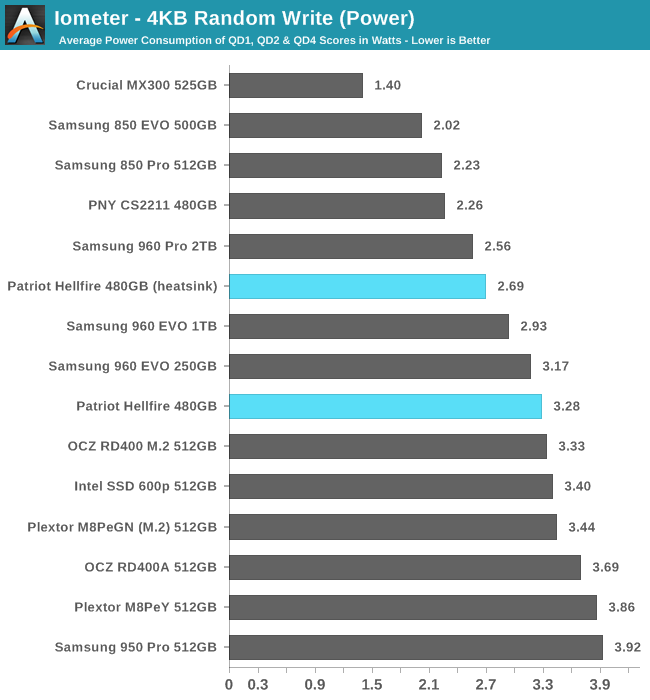
The Patriot Hellfire delivers better efficiency than most other NVMe SSDs and thanks to its good performance it is even substantially more efficient than the lower-power SATA SSDs.
 |
|||||||||
With or without a heatsink, the Patriot Hellfire's random write speed tops out at QD4 around 600MB/s. Most SSDs experience little to no improvement past this point. The Plextor M8Pe continues to slowly improve, but at QD4 its performance is sub-par.










43 Comments
View All Comments
BrokenCrayons - Tuesday, February 14, 2017 - link
Or Ripjaws...ugh where's my dentist at? It must work or at least not hurt sales too much if companies haven't stopped doing it yet. In fact, it's probably less about the name and more about product differentiation. Everyone sells a NVMe SSD but only one company sells a Hellfire NVMe SSD. Everyone sells a 32GB dual channel 3000MHz DDR4 kit but only one company sells a Viper version thereof for instance. Doing so, even with a relatively stupid name, leads to better brand recognition among consumers and we all know based on our experiences reading peoples' comments about computer hardware, cars, staplers, and energy drinks how important building brand loyalty becomes for those customers that can be sucked into the marketing.MR_Roberto - Monday, February 27, 2017 - link
Wait... so the ASUS Z97 Pro has NVMe M.2 PCIe 3 x4 ? .... I thought the motherbaord was limited to a M.2 PCIe 2x4 "2000 MB/max"........ because I have a ASUS Z97 PRO" wifi" and these means I can get a M.2 card /o/ , I was afraid my m.2 slot was limited and uselessUser11bfw - Saturday, July 28, 2018 - link
For no civic product „Hellfire“ is a reasonable name. Using the association with a deadly weapon exhibits a disgusting taste.